KIA Soul EV 2016 2.G Owner's Manual
Manufacturer: KIA, Model Year: 2016, Model line: Soul EV, Model: KIA Soul EV 2016 2.GPages: 524, PDF Size: 25.82 MB
Page 461 of 524
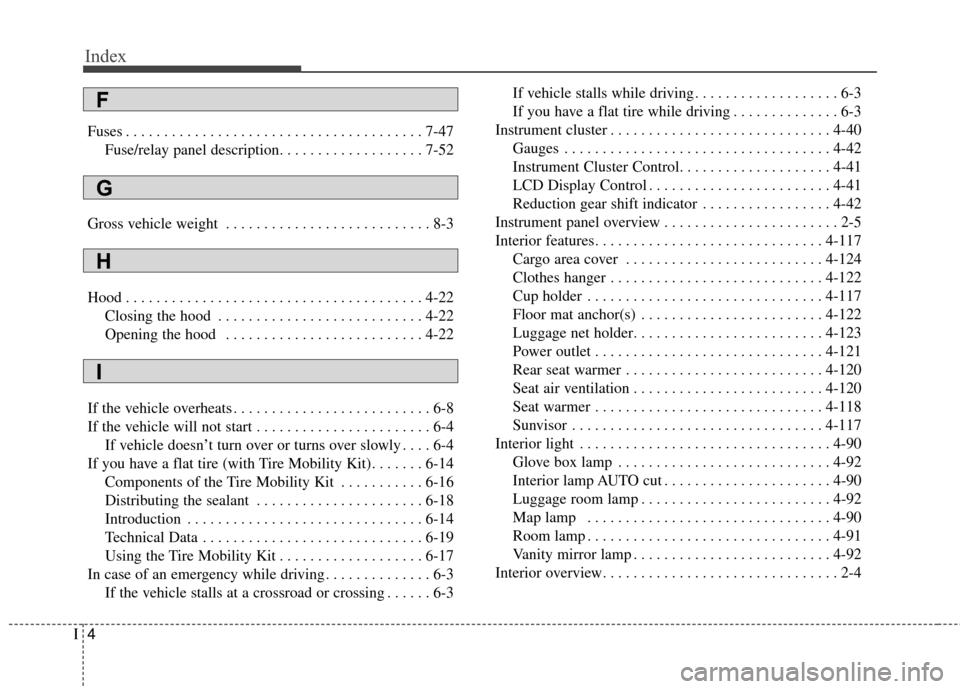
Index
4I
Fuses . . . . . . . . . . . . . . . . . . . . . . . . . . . . . . . . . . . . \
. . . 7-47Fuse/relay panel description. . . . . . . . . . . . . . . . . . . 7-52
Gross vehicle weight . . . . . . . . . . . . . . . . . . . . . . . . . . . 8-3
Hood . . . . . . . . . . . . . . . . . . . . . . . . . . . . . . . . . . . . \
. . . 4-22 Closing the hood . . . . . . . . . . . . . . . . . . . . . . . . . . . 4-22
Opening the hood . . . . . . . . . . . . . . . . . . . . . . . . . . 4-22
If the vehicle overheats . . . . . . . . . . . . . . . . . . . . . . . . . . 6-8
If the vehicle will not start . . . . . . . . . . . . . . . . . . . . . . . 6-4 If vehicle doesn’t turn over or turns over slowly . . . . 6-4
If you have a flat tire (with Tire Mobility Kit). . . . . . . 6-14 Components of the Tire Mobility Kit . . . . . . . . . . . 6-16
Distributing the sealant . . . . . . . . . . . . . . . . . . . . . . 6-18
Introduction . . . . . . . . . . . . . . . . . . . . . . . . . . . . . . . 6-14
Technical Data . . . . . . . . . . . . . . . . . . . . . . . . . . . . . 6-19
Using the Tire Mobility Kit . . . . . . . . . . . . . . . . . . . 6-17
In case of an emergency while driving . . . . . . . . . . . . . . 6-3 If the vehicle stalls at a crossroad or crossing . . . . . . 6-3 If vehicle stalls while driving . . . . . . . . . . . . . . . . . . . 6-3
If you have a flat tire while driving . . . . . . . . . . . . . . 6-3
Instrument cluster . . . . . . . . . . . . . . . . . . . . . . . . . . . . . 4-40 Gauges . . . . . . . . . . . . . . . . . . . . . . . . . . . . . . . . . . . 4-\
42
Instrument Cluster Control. . . . . . . . . . . . . . . . . . . . 4-41
LCD Display Control . . . . . . . . . . . . . . . . . . . . . . . . 4-41
Reduction gear shift indicator . . . . . . . . . . . . . . . . . 4-42
Instrument panel overview . . . . . . . . . . . . . . . . . . . . . . . 2-5
Interior features. . . . . . . . . . . . . . . . . . . . . . . . . . . . . . 4-117 Cargo area cover . . . . . . . . . . . . . . . . . . . . . . . . . . 4-124
Clothes hanger . . . . . . . . . . . . . . . . . . . . . . . . . . . . 4-122
Cup holder . . . . . . . . . . . . . . . . . . . . . . . . . . . . . . . 4-117
Floor mat anchor(s) . . . . . . . . . . . . . . . . . . . . . . . . 4-122
Luggage net holder. . . . . . . . . . . . . . . . . . . . . . . . . 4-123
Power outlet . . . . . . . . . . . . . . . . . . . . . . . . . . . . . . 4-121
Rear seat warmer . . . . . . . . . . . . . . . . . . . . . . . . . . 4-120
Seat air ventilation . . . . . . . . . . . . . . . . . . . . . . . . . 4-120
Seat warmer . . . . . . . . . . . . . . . . . . . . . . . . . . . . . . 4-118
Sunvisor . . . . . . . . . . . . . . . . . . . . . . . . . . . . . . . . . 4-117
Interior light . . . . . . . . . . . . . . . . . . . . . . . . . . . . . . . . . 4-90 Glove box lamp . . . . . . . . . . . . . . . . . . . . . . . . . . . . 4-92
Interior lamp AUTO cut . . . . . . . . . . . . . . . . . . . . . . 4-90
Luggage room lamp . . . . . . . . . . . . . . . . . . . . . . . . . 4-92
Map lamp . . . . . . . . . . . . . . . . . . . . . . . . . . . . . . . . 4-90
Room lamp . . . . . . . . . . . . . . . . . . . . . . . . . . . . . . . . 4-91
Vanity mirror lamp . . . . . . . . . . . . . . . . . . . . . . . . . . 4-92
Interior overview. . . . . . . . . . . . . . . . . . . . . . . . . . . . . . . 2-4
G
H
I
F
Page 462 of 524
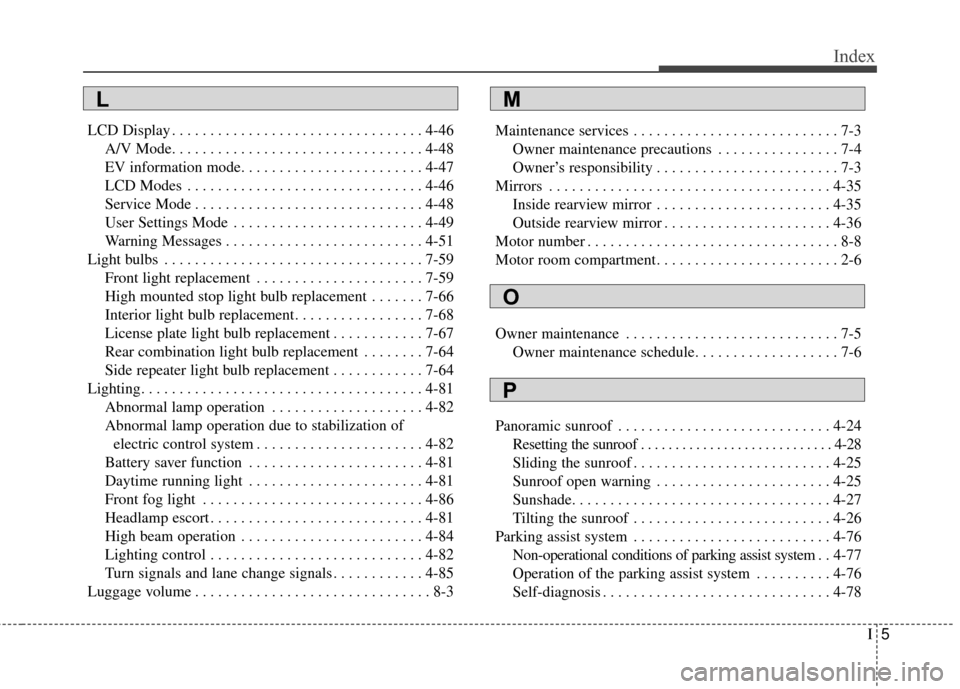
I5
Index
LCD Display . . . . . . . . . . . . . . . . . . . . . . . . . . . . . . . . . 4-46A/V Mode. . . . . . . . . . . . . . . . . . . . . . . . . . . . . . . . . 4-48
EV information mode. . . . . . . . . . . . . . . . . . . . . . . . 4-47
LCD Modes . . . . . . . . . . . . . . . . . . . . . . . . . . . . . . . 4-46
Service Mode . . . . . . . . . . . . . . . . . . . . . . . . . . . . . . 4-48
User Settings Mode . . . . . . . . . . . . . . . . . . . . . . . . . 4-49
Warning Messages . . . . . . . . . . . . . . . . . . . . . . . . . . 4-51
Light bulbs . . . . . . . . . . . . . . . . . . . . . . . . . . . . . . . . . . 7-59\
Front light replacement . . . . . . . . . . . . . . . . . . . . . . 7-59
High mounted stop light bulb replacement . . . . . . . 7-66
Interior light bulb replacement. . . . . . . . . . . . . . . . . 7-68
License plate light bulb replacement . . . . . . . . . . . . 7-67
Rear combination light bulb replacement . . . . . . . . 7-64
Side repeater light bulb replacement . . . . . . . . . . . . 7-64
Lighting. . . . . . . . . . . . . . . . . . . . . . . . . . . . . . . . . . . . \
. 4-81 Abnormal lamp operation . . . . . . . . . . . . . . . . . . . . 4-82
Abnormal lamp operation due to stabilization ofelectric control system . . . . . . . . . . . . . . . . . . . . . . 4-82
Battery saver function . . . . . . . . . . . . . . . . . . . . . . . 4-81
Daytime running light . . . . . . . . . . . . . . . . . . . . . . . 4-81
Front fog light . . . . . . . . . . . . . . . . . . . . . . . . . . . . . 4-86
Headlamp escort . . . . . . . . . . . . . . . . . . . . . . . . . . . . 4-81
High beam operation . . . . . . . . . . . . . . . . . . . . . . . . 4-84
Lighting control . . . . . . . . . . . . . . . . . . . . . . . . . . . . 4-82
Turn signals and lane change signals . . . . . . . . . . . . 4-85
Luggage volume . . . . . . . . . . . . . . . . . . . . . . . . . . . . . . . 8-3 Maintenance services . . . . . . . . . . . . . . . . . . . . . . . . . . . 7-3
Owner maintenance precautions . . . . . . . . . . . . . . . . 7-4
Owner’s responsibility . . . . . . . . . . . . . . . . . . . . . . . . 7-3
Mirrors . . . . . . . . . . . . . . . . . . . . . . . . . . . . . . . . . . . . \
. 4-35 Inside rearview mirror . . . . . . . . . . . . . . . . . . . . . . . 4-35
Outside rearview mirror . . . . . . . . . . . . . . . . . . . . . . 4-36
Motor number . . . . . . . . . . . . . . . . . . . . . . . . . . . . . . . . . 8-8
Motor room compartment. . . . . . . . . . . . . . . . . . . . . . . . 2-6
Owner maintenance . . . . . . . . . . . . . . . . . . . . . . . . . . . . 7-5 Owner maintenance schedule. . . . . . . . . . . . . . . . . . . 7-6
Panoramic sunroof . . . . . . . . . . . . . . . . . . . . . . . . . . . . 4-24 Resetting the sunroof . . . . . . . . . . . . . . . . . . . . . . . . . . . . 4-28
Sliding the sunroof . . . . . . . . . . . . . . . . . . . . . . . . . . 4-25
Sunroof open warning . . . . . . . . . . . . . . . . . . . . . . . 4-25
Sunshade. . . . . . . . . . . . . . . . . . . . . . . . . . . . . . . . . . 4-27\
Tilting the sunroof . . . . . . . . . . . . . . . . . . . . . . . . . . 4-26
Parking assist system . . . . . . . . . . . . . . . . . . . . . . . . . . 4-76 Non-operational conditions of parking assist system . . 4-77
Operation of the parking assist system . . . . . . . . . . 4-76
Self-diagnosis . . . . . . . . . . . . . . . . . . . . . . . . . . . . . . 4-78
M
O
P
L
Page 463 of 524
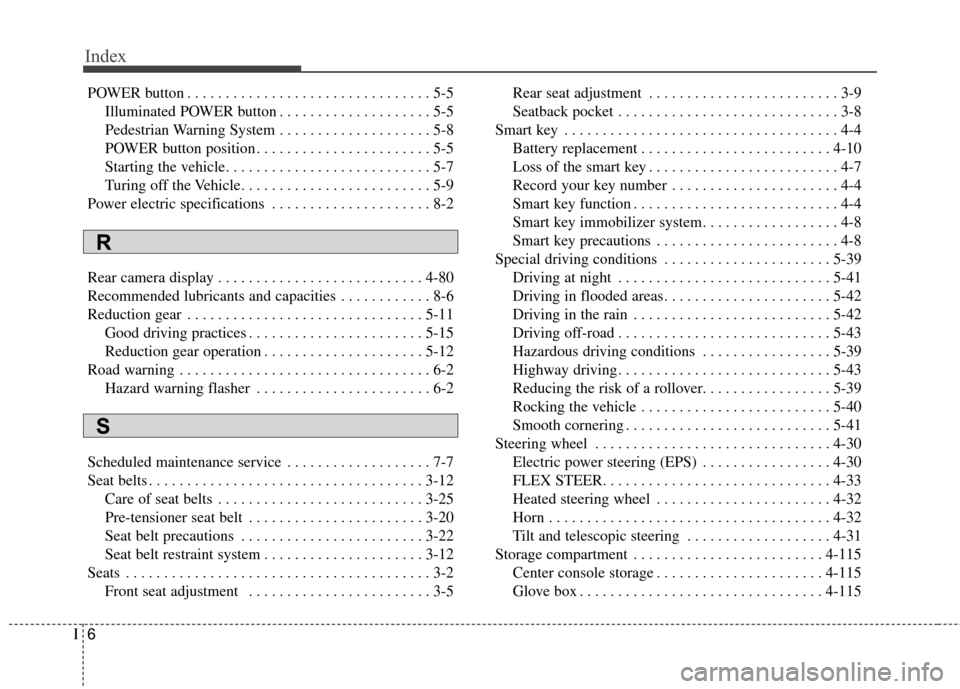
Index
6I
POWER button . . . . . . . . . . . . . . . . . . . . . . . . . . . . . . . . 5-5Illuminated POWER button . . . . . . . . . . . . . . . . . . . . 5-5
Pedestrian Warning System . . . . . . . . . . . . . . . . . . . . 5-8
POWER button position . . . . . . . . . . . . . . . . . . . . . . . 5-5
Starting the vehicle. . . . . . . . . . . . . . . . . . . . . . . . . . . 5-7
Turing off the Vehicle. . . . . . . . . . . . . . . . . . . . . . . . . 5-9
Power electric specifications . . . . . . . . . . . . . . . . . . . . . 8-2
Rear camera display . . . . . . . . . . . . . . . . . . . . . . . . . . . 4-80
Recommended lubricants and capacities . . . . . . . . . . . . 8-6
Reduction gear . . . . . . . . . . . . . . . . . . . . . . . . . . . . . . . 5-11 Good driving practices . . . . . . . . . . . . . . . . . . . . . . . 5-15
Reduction gear operation . . . . . . . . . . . . . . . . . . . . . 5-12
Road warning . . . . . . . . . . . . . . . . . . . . . . . . . . . . . . . . . 6-2 Hazard warning flasher . . . . . . . . . . . . . . . . . . . . . . . 6-2
Scheduled maintenance service . . . . . . . . . . . . . . . . . . . 7-7
Seat belts . . . . . . . . . . . . . . . . . . . . . . . . . . . . . . . . . . . . \
3-12 Care of seat belts . . . . . . . . . . . . . . . . . . . . . . . . . . . 3-25
Pre-tensioner seat belt . . . . . . . . . . . . . . . . . . . . . . . 3-20
Seat belt precautions . . . . . . . . . . . . . . . . . . . . . . . . 3-22
Seat belt restraint system . . . . . . . . . . . . . . . . . . . . . 3-12
Seats . . . . . . . . . . . . . . . . . . . . . . . . . . . . . . . . . . . . \
. . . . 3-2 Front seat adjustment . . . . . . . . . . . . . . . . . . . . . . . . 3-5 Rear seat adjustment . . . . . . . . . . . . . . . . . . . . . . . . . 3-9
Seatback pocket . . . . . . . . . . . . . . . . . . . . . . . . . . . . . 3-8
Smart key . . . . . . . . . . . . . . . . . . . . . . . . . . . . . . . . . . . . \
4-4 Battery replacement . . . . . . . . . . . . . . . . . . . . . . . . . 4-10
Loss of the smart key . . . . . . . . . . . . . . . . . . . . . . . . . 4-7
Record your key number . . . . . . . . . . . . . . . . . . . . . . 4-4
Smart key function . . . . . . . . . . . . . . . . . . . . . . . . . . . 4-4
Smart key immobilizer system. . . . . . . . . . . . . . . . . . 4-8
Smart key precautions . . . . . . . . . . . . . . . . . . . . . . . . 4-8
Special driving conditions . . . . . . . . . . . . . . . . . . . . . . 5-39 Driving at night . . . . . . . . . . . . . . . . . . . . . . . . . . . . 5-41
Driving in flooded areas. . . . . . . . . . . . . . . . . . . . . . 5-42
Driving in the rain . . . . . . . . . . . . . . . . . . . . . . . . . . 5-42
Driving off-road . . . . . . . . . . . . . . . . . . . . . . . . . . . . 5-43
Hazardous driving conditions . . . . . . . . . . . . . . . . . 5-39
Highway driving . . . . . . . . . . . . . . . . . . . . . . . . . . . . 5-43
Reducing the risk of a rollover. . . . . . . . . . . . . . . . . 5-39
Rocking the vehicle . . . . . . . . . . . . . . . . . . . . . . . . . 5-40
Smooth cornering . . . . . . . . . . . . . . . . . . . . . . . . . . . 5-41
Steering wheel . . . . . . . . . . . . . . . . . . . . . . . . . . . . . . . 4-30 Electric power steering (EPS) . . . . . . . . . . . . . . . . . 4-30
FLEX STEER. . . . . . . . . . . . . . . . . . . . . . . . . . . . . . 4-33
Heated steering wheel . . . . . . . . . . . . . . . . . . . . . . . 4-32
Horn . . . . . . . . . . . . . . . . . . . . . . . . . . . . . . . . . . . . \
. 4-32
Tilt and telescopic steering . . . . . . . . . . . . . . . . . . . 4-31
Storage compartment . . . . . . . . . . . . . . . . . . . . . . . . . 4-115 Center console storage . . . . . . . . . . . . . . . . . . . . . . 4-115
Glove box . . . . . . . . . . . . . . . . . . . . . . . . . . . . . . . . 4-115
R
S
Page 464 of 524
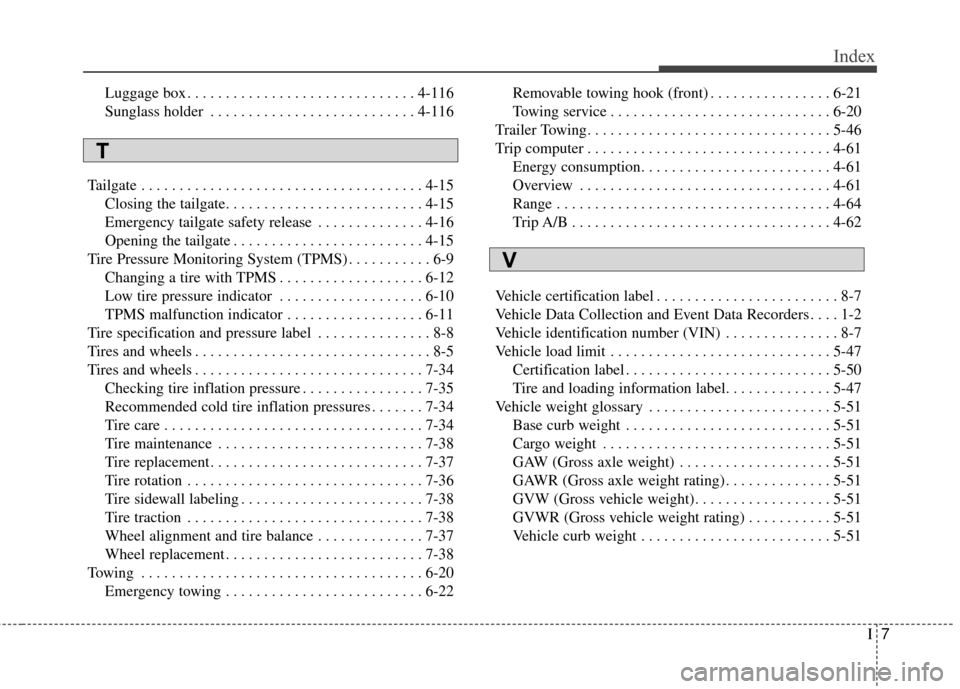
I7
Index
Luggage box . . . . . . . . . . . . . . . . . . . . . . . . . . . . . . 4-116
Sunglass holder . . . . . . . . . . . . . . . . . . . . . . . . . . . 4-116
Tailgate . . . . . . . . . . . . . . . . . . . . . . . . . . . . . . . . . . . . \
. 4-15 Closing the tailgate. . . . . . . . . . . . . . . . . . . . . . . . . . 4-15
Emergency tailgate safety release . . . . . . . . . . . . . . 4-16
Opening the tailgate . . . . . . . . . . . . . . . . . . . . . . . . . 4-15
Tire Pressure Monitoring System (TPMS) . . . . . . . . . . . 6-9 Changing a tire with TPMS . . . . . . . . . . . . . . . . . . . 6-12
Low tire pressure indicator . . . . . . . . . . . . . . . . . . . 6-10
TPMS malfunction indicator . . . . . . . . . . . . . . . . . . 6-11
Tire specification and pressure label . . . . . . . . . . . . . . . 8-8
Tires and wheels . . . . . . . . . . . . . . . . . . . . . . . . . . . . . . . 8-5
Tires and wheels . . . . . . . . . . . . . . . . . . . . . . . . . . . . . . 7-34 Checking tire inflation pressure . . . . . . . . . . . . . . . . 7-35
Recommended cold tire inflation pressures . . . . . . . 7-34
Tire care . . . . . . . . . . . . . . . . . . . . . . . . . . . . . . . . . . 7-34\
Tire maintenance . . . . . . . . . . . . . . . . . . . . . . . . . . . 7-38
Tire replacement . . . . . . . . . . . . . . . . . . . . . . . . . . . . 7-37
Tire rotation . . . . . . . . . . . . . . . . . . . . . . . . . . . . . . . 7-36
Tire sidewall labeling . . . . . . . . . . . . . . . . . . . . . . . . 7-38
Tire traction . . . . . . . . . . . . . . . . . . . . . . . . . . . . . . . 7-38
Wheel alignment and tire balance . . . . . . . . . . . . . . 7-37
Wheel replacement . . . . . . . . . . . . . . . . . . . . . . . . . . 7-38
Towing . . . . . . . . . . . . . . . . . . . . . . . . . . . . . . . . . . . . \
. 6-20 Emergency towing . . . . . . . . . . . . . . . . . . . . . . . . . . 6-22 Removable towing hook (front) . . . . . . . . . . . . . . . . 6-21
Towing service . . . . . . . . . . . . . . . . . . . . . . . . . . . . . 6-20
Trailer Towing. . . . . . . . . . . . . . . . . . . . . . . . . . . . . . . . 5-46
Trip computer . . . . . . . . . . . . . . . . . . . . . . . . . . . . . . . . 4-61 Energy consumption. . . . . . . . . . . . . . . . . . . . . . . . . 4-61
Overview . . . . . . . . . . . . . . . . . . . . . . . . . . . . . . . . . 4-61
Range . . . . . . . . . . . . . . . . . . . . . . . . . . . . . . . . . . . . \
4-64
Trip A/B . . . . . . . . . . . . . . . . . . . . . . . . . . . . . . . . . . 4-62\
Vehicle certification label . . . . . . . . . . . . . . . . . . . . . . . . 8-7
Vehicle Data Collection and Event Data Recorders . . . . 1-2
Vehicle identification number (VIN) . . . . . . . . . . . . . . . 8-7
Vehicle load limit . . . . . . . . . . . . . . . . . . . . . . . . . . . . . 5-47 Certification label . . . . . . . . . . . . . . . . . . . . . . . . . . . 5-50
Tire and loading information label. . . . . . . . . . . . . . 5-47
Vehicle weight glossary . . . . . . . . . . . . . . . . . . . . . . . . 5-51 Base curb weight . . . . . . . . . . . . . . . . . . . . . . . . . . . 5-51
Cargo weight . . . . . . . . . . . . . . . . . . . . . . . . . . . . . . 5-51
GAW (Gross axle weight) . . . . . . . . . . . . . . . . . . . . 5-51
GAWR (Gross axle weight rating) . . . . . . . . . . . . . . 5-51
GVW (Gross vehicle weight). . . . . . . . . . . . . . . . . . 5-51
GVWR (Gross vehicle weight rating) . . . . . . . . . . . 5-51
Vehicle curb weight . . . . . . . . . . . . . . . . . . . . . . . . . 5-51
V
T
Page 465 of 524
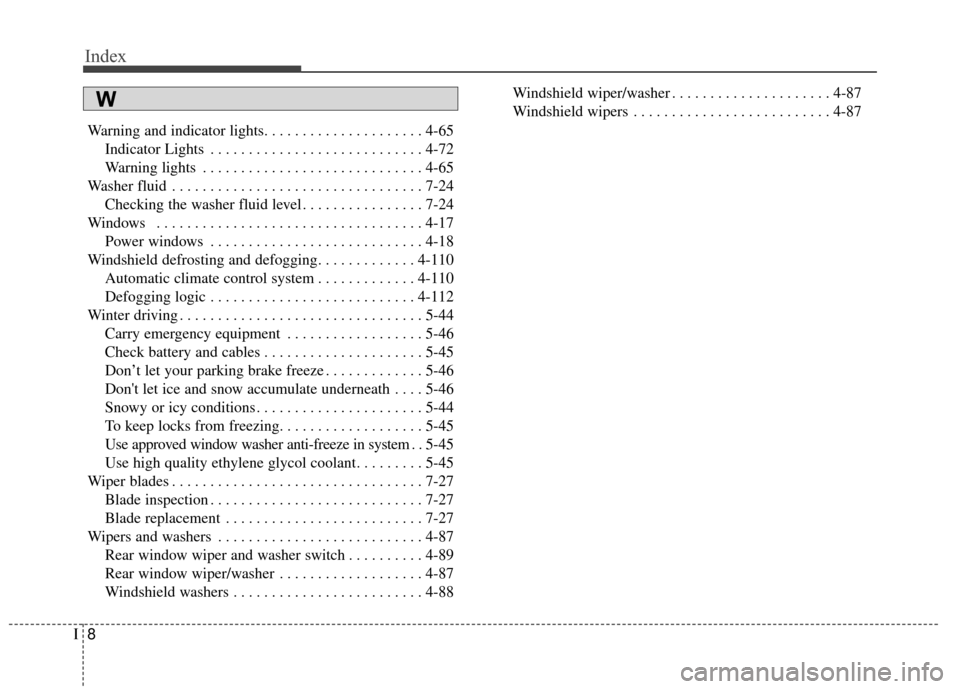
Index
8I
Warning and indicator lights. . . . . . . . . . . . . . . . . . . . . 4-65Indicator Lights . . . . . . . . . . . . . . . . . . . . . . . . . . . . 4-72
Warning lights . . . . . . . . . . . . . . . . . . . . . . . . . . . . . 4-65
Washer fluid . . . . . . . . . . . . . . . . . . . . . . . . . . . . . . . . . 7-24 Checking the washer fluid level . . . . . . . . . . . . . . . . 7-24
Windows . . . . . . . . . . . . . . . . . . . . . . . . . . . . . . . . . . . 4-\
17 Power windows . . . . . . . . . . . . . . . . . . . . . . . . . . . . 4-18
Windshield defrosting and defogging. . . . . . . . . . . . . 4-110 Automatic climate control system . . . . . . . . . . . . . 4-110
Defogging logic . . . . . . . . . . . . . . . . . . . . . . . . . . . 4-112
Winter driving . . . . . . . . . . . . . . . . . . . . . . . . . . . . . . . . 5-44 Carry emergency equipment . . . . . . . . . . . . . . . . . . 5-46
Check battery and cables . . . . . . . . . . . . . . . . . . . . . 5-45
Don’t let your parking brake freeze . . . . . . . . . . . . . 5-46
Don't let ice and snow accumulate underneath . . . . 5-46
Snowy or icy conditions . . . . . . . . . . . . . . . . . . . . . . 5-44
To keep locks from freezing. . . . . . . . . . . . . . . . . . . 5-45
Use approved window washer anti-freeze in system . . 5-45
Use high quality ethylene glycol coolant. . . . . . . . . 5-45
Wiper blades . . . . . . . . . . . . . . . . . . . . . . . . . . . . . . . . . 7-27 Blade inspection . . . . . . . . . . . . . . . . . . . . . . . . . . . . 7-27
Blade replacement . . . . . . . . . . . . . . . . . . . . . . . . . . 7-27
Wipers and washers . . . . . . . . . . . . . . . . . . . . . . . . . . . 4-87 Rear window wiper and washer switch . . . . . . . . . . 4-89
Rear window wiper/washer . . . . . . . . . . . . . . . . . . . 4-87
Windshield washers . . . . . . . . . . . . . . . . . . . . . . . . . 4-88 Windshield wiper/washer . . . . . . . . . . . . . . . . . . . . . 4-87
Windshield wipers . . . . . . . . . . . . . . . . . . . . . . . . . . 4-87
W
Page 466 of 524
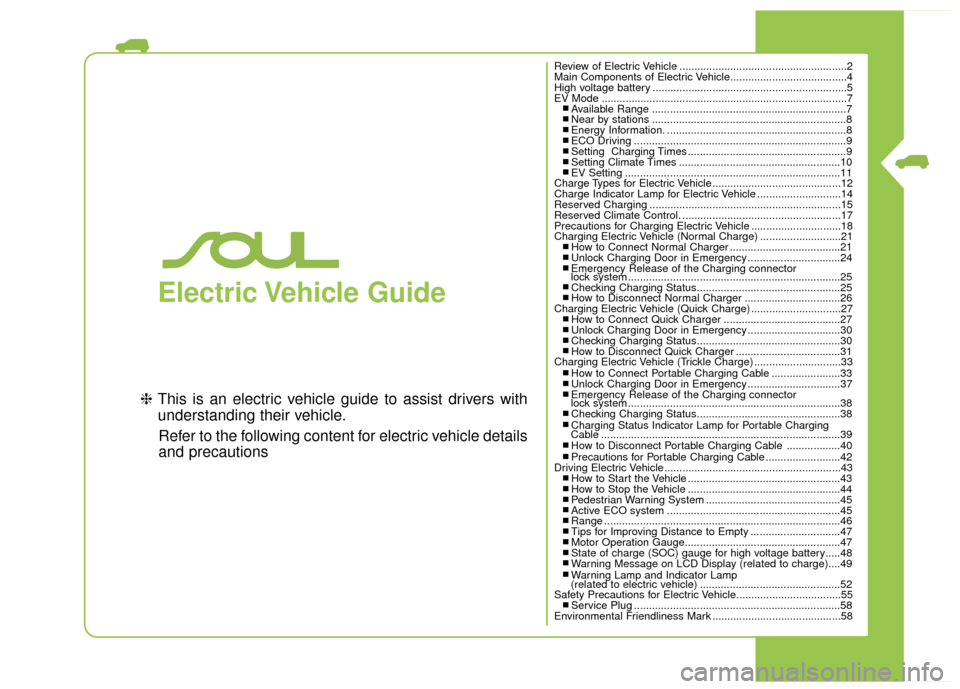
Electric Vehicle Guide
❈This is an electric vehicle guide to assist drivers with
understanding their vehicle.
Refer to the following content for electric vehicle details
and precautions
Review of Electric Vehicle ........................................................2
Main Components of Electric Vehicle.......................................4
High voltage battery .................................................................5
EV Mode ........................................................................\
..........7
■ Available Range .................................................................7■ Near by stations .................................................................8■ Energy Information. ............................................................8■ ECO Driving .......................................................................9\
■ Setting Charging Times .....................................................9■ Setting Climate Times ......................................................10■ EV Setting ........................................................................\
11
Charge Types for Electric Vehicle...........................................12
Charge Indicator Lamp for Electric Vehicle ............................14
Reserved Charging ................................................................15
Reserved Climate Control. .....................................................17
Precautions for Charging Electric Vehicle ..............................18
Charging Electric Vehicle (Normal Charge) ...........................21
■ How to Connect Normal Charger .....................................21■ Unlock Charging Door in Emergency ...............................24■ Emergency Release of the Charging connector
lock system .......................................................................2\
5
■ Checking Charging Status................................................25■ How to Disconnect Normal Charger ................................26
Charging Electric Vehicle (Quick Charge) ..............................27
■ How to Connect Quick Charger .......................................27■ Unlock Charging Door in Emergency ...............................30■ Checking Charging Status................................................30■ How to Disconnect Quick Charger ...................................31
Charging Electric Vehicle (Trickle Charge) .............................33
■ How to Connect Portable Charging Cable .......................33■ Unlock Charging Door in Emergency ...............................37■ Emergency Release of the Charging connector
lock system .......................................................................3\
8
■ Checking Charging Status................................................38■ Charging Status Indicator Lamp for Portable Charging
Cable ........................................................................\
........39
■ How to Disconnect Portable Charging Cable ..................40■ Precautions for Portable Charging Cable .........................42
Driving Electric Vehicle ...........................................................43
■ How to Start the Vehicle ...................................................43■ How to Stop the Vehicle ...................................................44■ Pedestrian Warning System .............................................45■ Active ECO system ..........................................................45■ Range ........................................................................\
.......46■ Tips for Improving Distance to Empty ..............................47■ Motor Operation Gauge....................................................47■ State of charge (SOC) gauge for high voltage battery.....48■ Warning Message on LCD Display (related to charge)....49■ Warning Lamp and Indicator Lamp
(related to electric vehicle) ...............................................52
Safety Precautions for Electric Vehicle...................................55
■ Service Plug .....................................................................58
Environmental Friendliness Mark ...........................................58
Page 467 of 524
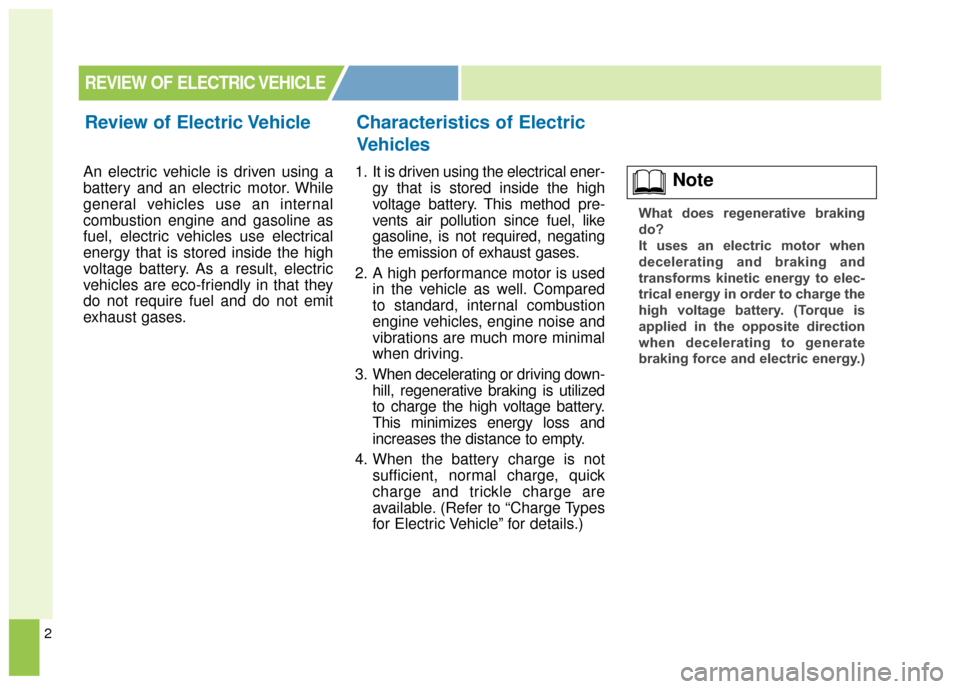
2
An electric vehicle is driven using a
battery and an electric motor. While
general vehicles use an internal
combustion engine and gasoline as
fuel, electric vehicles use electrical
energy that is stored inside the high
voltage battery. As a result, electric
vehicles are eco-friendly in that they
do not require fuel and do not emit
exhaust gases.1. It is driven using the electrical ener-
gy that is stored inside the high
voltage battery. This method pre-
vents air pollution since fuel, like
gasoline, is not required, negating
the emission of exhaust gases.
2. A high performance motor is used in the vehicle as well. Compared
to standard, internal combustion
engine vehicles, engine noise and
vibrations are much more minimal
when driving.
3. When decelerating or driving down- hill, regenerative braking is utilized
to charge the high voltage battery.
This minimizes energy loss and
increases the distance to empty.
4. When the battery charge is not sufficient, normal charge, quick
charge and trickle charge are
available. (Refer to “Charge Types
for Electric Vehicle” for details.)
REVIEW OF ELECTRIC VEHICLE
Review of Electric Vehicle Characteristics of Electric
Vehicles
What does regenerative braking
do?
It uses an electric motor when
decelerating and braking and
transforms kinetic energy to elec-
trical energy in order to charge the
high voltage battery. (Torque is
applied in the opposite direction
when decelerating to generate
braking force and electric energy.)
Note
Page 468 of 524
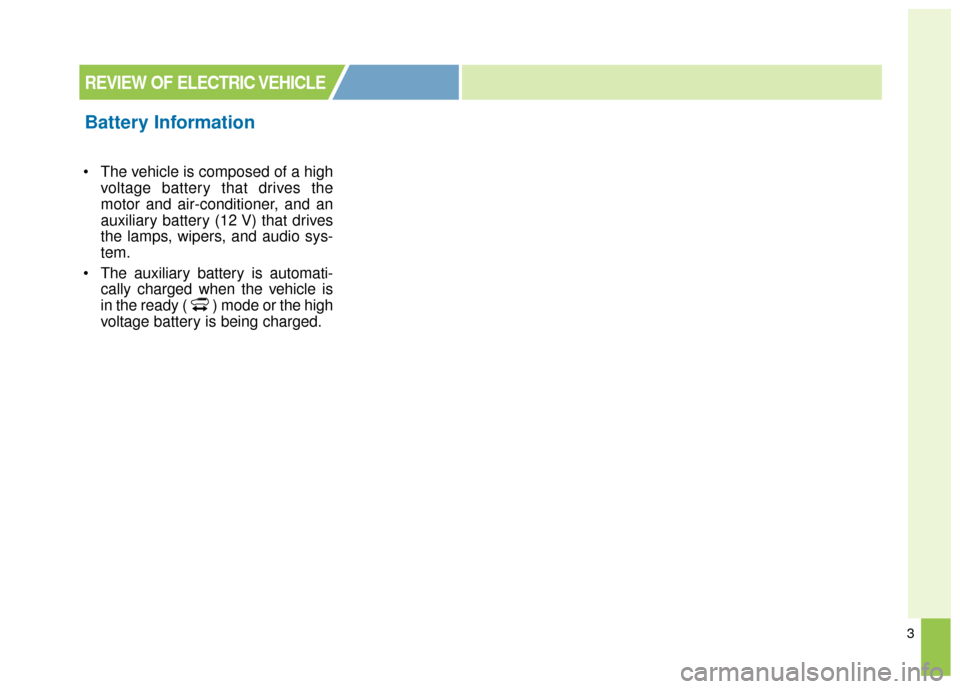
3
The vehicle is composed of a highvoltage battery that drives the
motor and air-conditioner, and an
auxiliary battery (12 V) that drives
the lamps, wipers, and audio sys-
tem.
The auxiliary battery is automati- cally charged when the vehicle is
in the ready ( ) mode or the high
voltage battery is being charged.
REVIEW OF ELECTRIC VEHICLE
Battery Information
Page 469 of 524
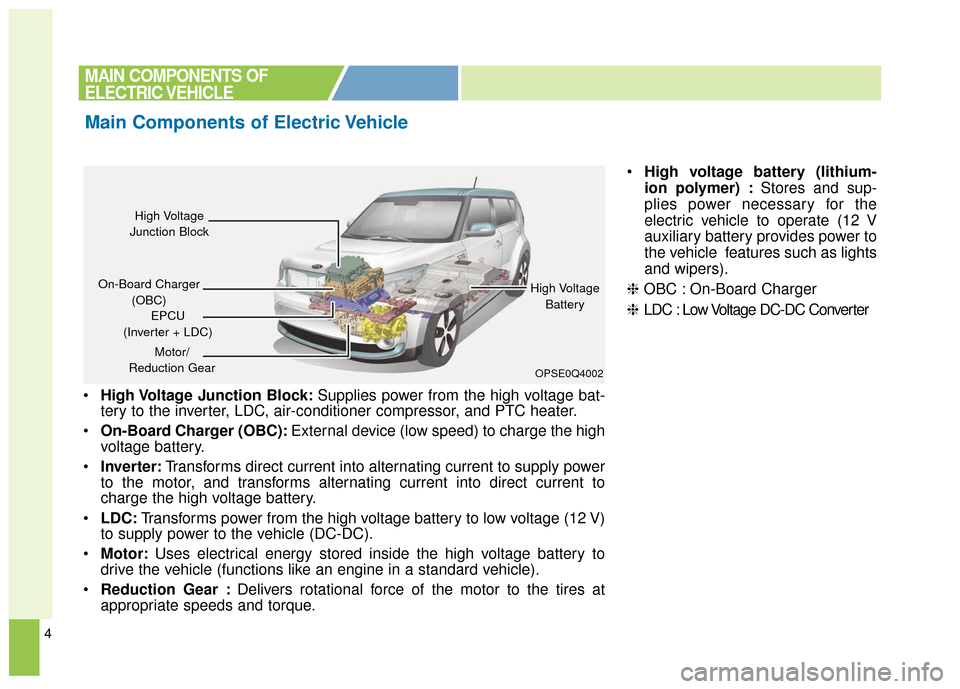
4
High Voltage Junction Block: Supplies power from the high voltage bat-
tery to the inverter, LDC, air-conditioner compressor, and PTC heater.
On-Board Charger (OBC): External device (low speed) to charge the high
voltage battery.
Inverter: Transforms direct current into alternating current to supply power
to the motor, and transforms alternating current into direct current to
charge the high voltage battery.
LDC: Transforms power from the high voltage battery to low voltage (12 V)
to supply power to the vehicle (DC-DC).
Motor: Uses electrical energy stored inside the high voltage battery to
drive the vehicle (functions like an engine in a standard vehicle).
Reduction Gear : Delivers rotational force of the motor to the tires at
appropriate speeds and torque.
High voltage battery (lithium-
ion polymer) : Stores and sup-
plies power necessary for the
electric vehicle to operate (12 V
auxiliary battery provides power to
the vehicle features such as lights
and wipers).
❈ OBC : On-Board Charger
❈ LDC : Low Voltage DC-DC Converter
MAIN COMPONENTS OF
ELECTRIC VEHICLE
Main Components of Electric Vehicle
OPSE0Q4002
High Voltage
Junction Block
On-Board Charger (OBC) High Voltage
Battery
EPCU
(Inverter + LDC)
Motor/
Reduction Gear
Page 470 of 524
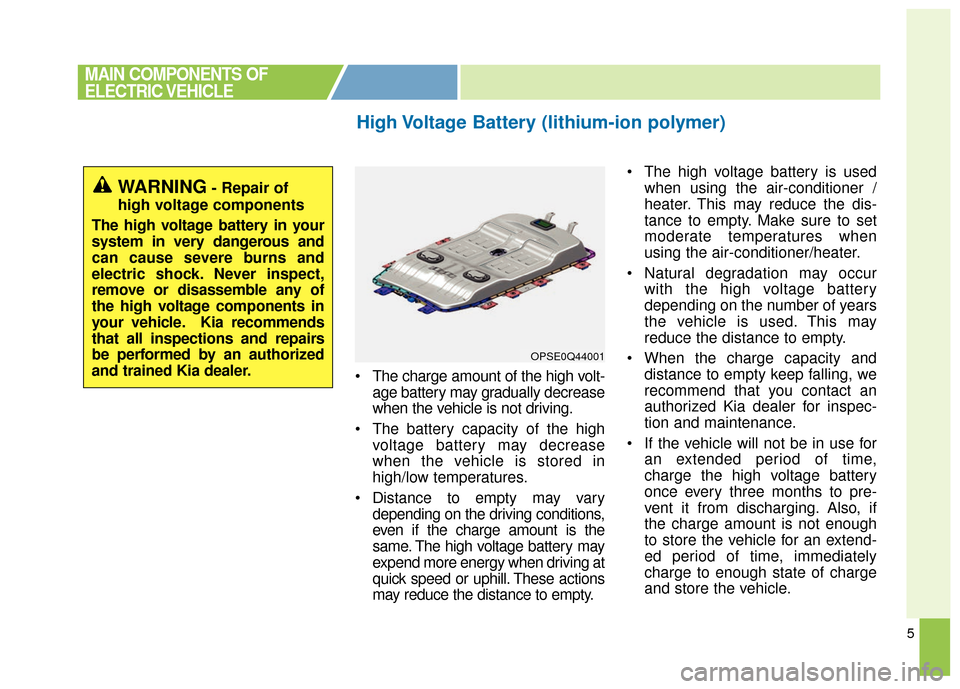
5
The charge amount of the high volt-age battery may gradually decrease
when the vehicle is not driving.
The battery capacity of the high voltage battery may decrease
when the vehicle is stored in
high/low temperatures.
Distance to empty may vary depending on the driving conditions,
even if the charge amount is the
same. The high voltage battery may
expend more energy when driving at
quick speed or uphill. These actions
may reduce the distance to empty. The high voltage battery is used
when using the air-conditioner /
heater. This may reduce the dis-
tance to empty. Make sure to set
moderate temperatures when
using the air-conditioner/heater.
Natural degradation may occur with the high voltage battery
depending on the number of years
the vehicle is used. This may
reduce the distance to empty.
When the charge capacity and distance to empty keep falling, we
recommend that you contact an
authorized Kia dealer for inspec-
tion and maintenance.
If the vehicle will not be in use for an extended period of time,
charge the high voltage battery
once every three months to pre-
vent it from discharging. Also, if
the charge amount is not enough
to store the vehicle for an extend-
ed period of time, immediately
charge to enough state of charge
and store the vehicle.
High Voltage Battery (lithium-ion polymer)
MAIN COMPONENTS OF
ELECTRIC VEHICLE
OPSE0Q44001
WARNING- Repair of
high voltage components
The high voltage battery in your
system in very dangerous and
can cause severe burns and
electric shock. Never inspect,
remove or disassemble any of
the high voltage components in
your vehicle. Kia recommends
that all inspections and repairs
be performed by an authorized
and trained Kia dealer.